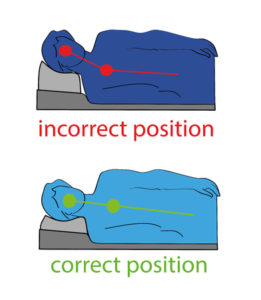
Waking up with Neck Pain?
Waking up with Neck Pain?
Everything You Need to Know About Sleeping on Your Side
- You may need one or two pillows to support your head and neck while lying on your side. It mostly depends on the breadth of your shoulders, but also on the shape and size of your head. Ideally, your neck (cervical spine) should be in line with the rest of your spine to prevent neck pain.
Wrong Sized Pillows
- Wrong sized pillows can be detrimental and cause neck pain. Pillows which are too big can push your neck and head upwards. This may overstretch muscles and ligaments on one side of your neck and compress or impinge cervical neck joints on the opposite side. A pillow which is too low will not support your neck as your head tilts downwards. Over many years, this can strain your neck muscles, ligaments and joints and may ultimately result in neck pain.
- If you are not sure if your pillow is right for you, have someone take a photo of you lying on your side and see for yourself. Photo’s should be taken from in front and behind. Make sure your neck is clearly visible and not covered by hair or clothing. Observe your head and neck position relative to your pillow and check the support under your neck. From the front view, your forehead, nose and chin should line up with your breastbone (sternum). From behind, your neck should remain in line with the rest of your spine. You should not see a gap between your neck and the pillow.
- A telling sign that your pillow may be too low is if you find yourself always needing to snug your hand or forearm under your neck or head to fall or stay asleep. It may also be that you place your hand under your pillow to add extra support. Your pillow should offer the correct support to your neck that you do not need additional hand support.
Using One Pillow
- If using only one pillow, ensure that the pillow buttresses against your shoulder and that your neck is supported by the pillow. There should be no gap between your neck and the pillow. You shouldn’t be able to pass your hand between your neck and the pillow.
- If there is a slight gap between your neck and your pillow but the pillow size seems generally right to support your head – try putting a small rolled hand towel at the long side of your pillow edge. Placing the rolled towel inside your pillowcase will keep it in place. Alternatively, try using a pillow with a rounded contoured edge to ensure support to your neck.
Using Two Pillows
- Often, two pillows are needed to adequately support your neck and head. The lower pillow should be snug against your shoulder, while the upper pillow is snug into supporting your neck. Your head should rest comfortably on the pillow along the side of your head and only lightly on the cheek. You do not want to feel unwanted pressure on your jaw. There should not be a gap between your pillow and your neck.
- Placing a pillow between your legs adds additional support for your lower body. This may provide more support to your upper leg and hip and keep your back and pelvis more level.
Body Pillows
- Neck pain will be more aggravated by lying on your stomach. To keep yourself on your side, try using a body pillow along your front side to prevent rolling over onto your stomach. Your lower leg can remain relatively straight, while your upper leg rests on top of the pillow. A body pillow could also be placed behind you to prevent rolling onto your back, if back sleeping is not optimal for you. The presence of a long pillow along your body can provide additional sensory comfort and support.
The photo below shows inadequate pillow support with the head dropping downwards and neck not properly supported.

Additionally, the photo below displays a pillow that is a little too high and the head is being pushed upwards.

The vector diagram displays the incorrect and correct positioning for the pillow and neck:

Leah Segelov, PT, MA is a Physical Therapist for over 20 years and owner of Segelov Physical Therapy, PLLC in Manhattan, New York. She may be contacted via e-mail at leah@segelovpt.com.
Leah specializes in musculoskeletal and orthopedic conditions, TMJ disorders and facial paralysis.
Blog updates can be emailed directly to your inbox. Please subscribe on the home page www.segelovpt.com
Disclaimer: The entire content on this blog is for educational and informational purposes only. No responsibility is taken or assumed for any action taken by the website user as a result of information on this website. Website users should seek their own professional advice regarding their individual situation as to whether a specific or general treatment, remedy or exercise is appropriate for their condition.

 Previous Post
Previous Post



 © copyright 2015 Segelov Physical Therapy, PLLC. All rights reserved.
© copyright 2015 Segelov Physical Therapy, PLLC. All rights reserved.